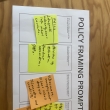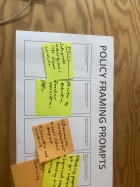Unleashing the Potential of STEAM and Maker Pedagogy
9. Apr 2024
In a world grappling with significant challenges such as climate change and biodiversity loss, the necessity for not only more scientists but also a society that embraces science with enthusiasm and understanding has never been more critical. However, the journey towards scientific literacy often encounters obstacles early on, rooted deeply in the educational experiences provided at schools. A shift in perspective and methodology is urgently required to make STEM (Science, Technology, Engineering, Mathematics) education more inclusive, engaging, and relevant to today's complex world. This is where the transformation to STEAM—incorporating 'Arts' into STEM—coupled with Maker Pedagogy, comes into play, offering a promising avenue towards social innovation in education.
Maker Pedagogy: Hands-on Learning for Real-world Problem Solving
At the core of the STEAM approach lies Maker Pedagogy, a transformative educational practice that emphasizes hands-on learning through design, creation, and collaboration in makerspaces. This method not only fosters creativity and collaboration but also cultivates a sense of ownership and relevance in learners, enabling them to discern the practical application of learning by doing and represents a significant departure towards recognizing education as a catalyst for social innovation.
Social Innovation in Education: Beyond the Classroom
The journey towards embedding STEAM and Maker Pedagogy into educational systems is akin to navigating through an obstacle course laden with systemic barriers. The transition requires concerted efforts from educators, policymakers, and the community to dismantle the "hostile obstacle course" and pave the way for a more inclusive and engaging educational landscape.
Transitioning from STEM to STEAM maker education represents a form of “social innovation in education”, as defined by the Centre for Social Innovation: “Social innovations are new concepts and measures for solving social challenges that are accepted and utilized by social groups affected” (Centre for Social Innovation, n.d.). The impact of this innovation can range from individual to societal levels. However, for this approach to truly qualify as a social innovation, it must be adopted and implemented by educational institutions.
Drafting a Policy Recommendation for Integrating Makerspace in School Curricula
Within the framework of a workshop attended by approximately 40 stakeholders, including representative from schools, member of the mAkE – African European Maker Innovatoin Ecosystem (https://makeafricaeu.org/) and DBB – The Distributed Design Platform (https://distributeddesign.eu/) projects, researchers, members of makerspaces, pedagogues, and non-profit organisations, the conditions for adopting STEAM approaches and formulating policy recommendations were thoroughly discussed.
Taking place during the consortium meeting of the mAkE and DBB project, the 2-hour workshop was structured into various group and working sessions, with each group compromising around 8 participants. This workshop occurred on March 15, 2024, in Barcelona, Spain. Each group focused on developing distinct policy recommendations, utilizing a template provided by Distributed Design. This template, known as the policy framing prompts, was designed to guide group discussions and explorations.
-
What is the policy you would like to change or influence?
-
Who are the policymakers you would need to convince?
-
What is the entry point to grab the attention of these policymakers?
-
What are the winning points to convince this policymaker of your position?
-
What is the long-term change you would see if policy shifted in your favour?
-
What would the direct benefit be?
-
What would the wider benefits be?
-
What should this policymaker do?
During the workshop, the results of each step of the template were recorded on post-it notes and later shared with all participants. Towards the end of the session, one representative from each group assumed the role of a “speaker” and presented the group’s elaborated ideas to the others.
In this setting, Claudia Magdalena Fabian from ZSI (Centre for Social Innovation) shared initial insights derived from the RoadSTEAMer project with fellow group members. Inspired by these insights, the group embarked on drafting a policy recommendation centred around the integration of makerspaces into school curricula. This collaborative effort aimed to explore innovative approaches to incorporate makerspaces effectively in educational settings.
During the discussion, it became evident that the primary target groups for the proposed actions are the Ministry of Education, teacher associations, and Members of the Parliament. To initiate discussions and capture the attention of these stakeholders, workshop participants recommended highlighting the benefits of the proposed actions, such as reducing unemployment, decreasing school dropouts, and fostering innovation and creativity among young people and future employees.
The integration of makerspaces into schools and curricula was seen as a means to make young people prepared for employment while enhancing teaching and learning through hands-on activities and project-based learning. This approach aims to help students understand the interconnectedness of different disciplines and how to apply them in real-life situations, contributing to their skill development and self-awareness.
To optimize learning transfer and develop employability skills, the workshop participants suggested involving companies or local SMEs in the learning process. This could include students gaining first insights through job shadowing or participating in real-life projects during their summer holidays or school time. Encouraging companies and SMEs to fund makerspaces or teacher training was also recommended, as they stand to benefit from having better-educated and experienced future employees.
To maintain the openness and quality of educational materials and approaches, it was emphasized that the main sources of funding should still come from government and public bodies, such as local municipalities. By integrating companies or local SMEs more into school education and creating makerspaces within schools or renting spaces in local makerspaces, as well as training teacher to support this approach, learning in schools can become more exciting and practical.
Since RoadSTEAMer aims to develop a roadmap for science education in Horizon Europe and educational policy, the findings described above are viewed as a starting point for a more systematic analysis of the conditions and requirements of a STEAM approach with a policy roadmap as the end goal. This systematic analysis will provide a comprehensive framework for advancing STEAM education in policy and practice.
Author: Claudia Magdalena Fabian & Elisabeth Unterfrauner
Verwandte Artikel:
Tags: science education, STEAM, STEM
















































